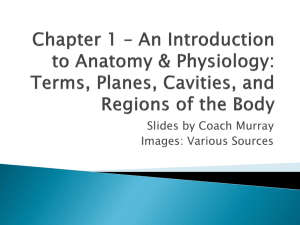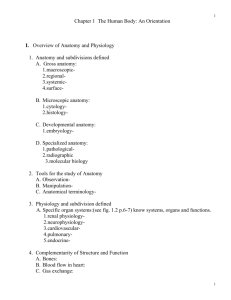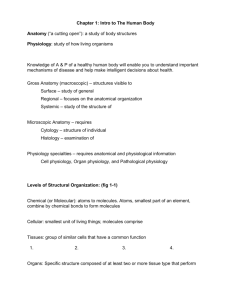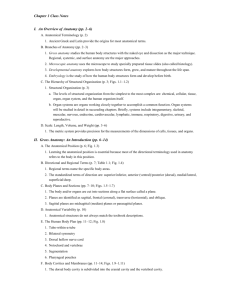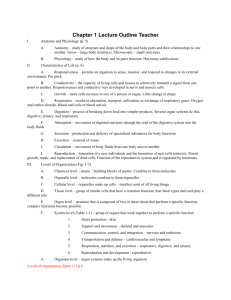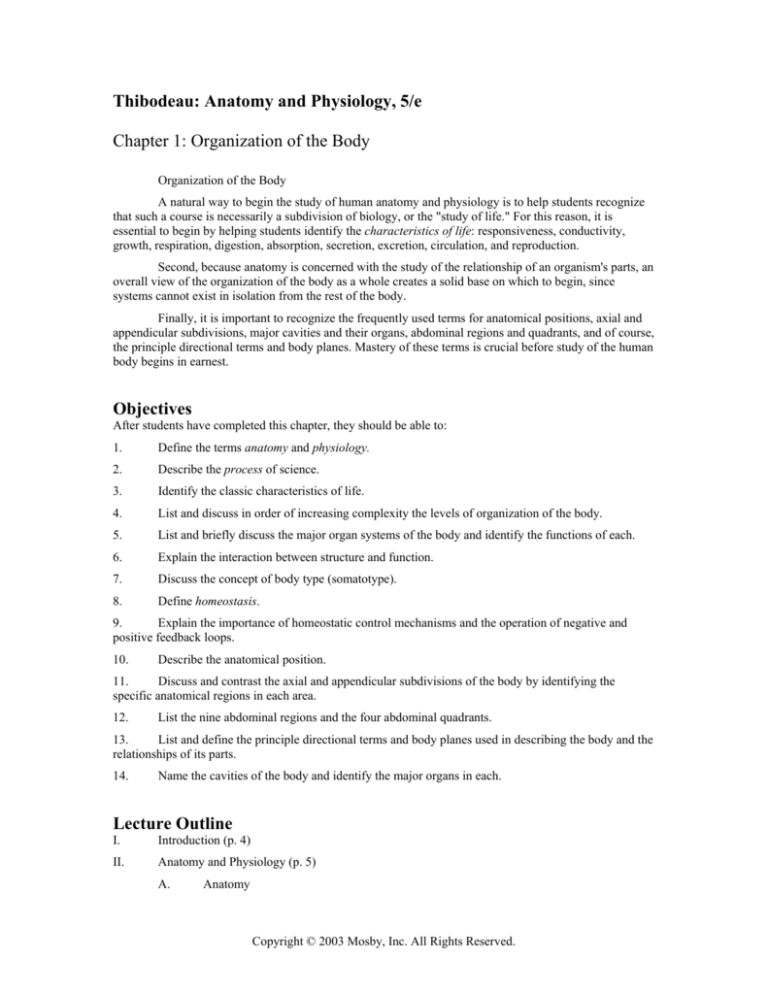
Thibodeau: Anatomy and Physiology, 5/e
Chapter 1: Organization of the Body
Organization of the Body
A natural way to begin the study of human anatomy and physiology is to help students recognize
that such a course is necessarily a subdivision of biology, or the "study of life." For this reason, it is
essential to begin by helping students identify the characteristics of life: responsiveness, conductivity,
growth, respiration, digestion, absorption, secretion, excretion, circulation, and reproduction.
Second, because anatomy is concerned with the study of the relationship of an organism's parts, an
overall view of the organization of the body as a whole creates a solid base on which to begin, since
systems cannot exist in isolation from the rest of the body.
Finally, it is important to recognize the frequently used terms for anatomical positions, axial and
appendicular subdivisions, major cavities and their organs, abdominal regions and quadrants, and of course,
the principle directional terms and body planes. Mastery of these terms is crucial before study of the human
body begins in earnest.
Objectives
After students have completed this chapter, they should be able to:
1.
Define the terms anatomy and physiology.
2.
Describe the process of science.
3.
Identify the classic characteristics of life.
4.
List and discuss in order of increasing complexity the levels of organization of the body.
5.
List and briefly discuss the major organ systems of the body and identify the functions of each.
6.
Explain the interaction between structure and function.
7.
Discuss the concept of body type (somatotype).
8.
Define homeostasis.
9.
Explain the importance of homeostatic control mechanisms and the operation of negative and
positive feedback loops.
10.
Describe the anatomical position.
11.
Discuss and contrast the axial and appendicular subdivisions of the body by identifying the
specific anatomical regions in each area.
12.
List the nine abdominal regions and the four abdominal quadrants.
13.
List and define the principle directional terms and body planes used in describing the body and the
relationships of its parts.
14.
Name the cavities of the body and identify the major organs in each.
Lecture Outline
I.
Introduction (p. 4)
II.
Anatomy and Physiology (p. 5)
A.
Anatomy
Copyright © 2003 Mosby, Inc. All Rights Reserved.
Chapter 1: Organization of the Body
B.
III.
IV.
V.
Physiology
The Process of Science (Fig. 1-1)
A.
Observations
B.
Hypothesis
C.
Experiment
D.
Theory
E.
Law
Characteristics of Life (p. 6)
A.
Responsiveness
B.
Conductivity
C.
Growth
D.
Respiration
E.
Digestion
F.
Absorption
G.
Secretion
H.
Excretion
I.
Circulation
J.
Reproduction
Levels of Organization (Fig. 1-3)
A.
Chemical level
B.
Organelle level
C.
Cellular level
D.
Tissue level
E.
Organ level
F.
System level (Table 1-1)
F.
1.
Outer protection
2.
Support and movement
3.
Communication, control, and integration
4.
Transportation and defense
5.
Processing, regulation, and maintenance
6.
Reproduction and development
Organism level
VI.
Anatomical Position (Fig. 1-4)
VII.
Body Cavities (Fig. 1-5)
A.
Ventral cavity (Table 1-2)
1.
Thoracic cavity
2.
Abdominopelvic cavity
Copyright © 2003 Mosby, Inc. All Rights Reserved.
2
Chapter 1: Organization of the Body
B.
VIII.
IX.
Dorsal cavity
1.
Cranial cavity
2.
Spinal cavity
Body Regions (Fig. 1-6, Table 1-3)
A.
Abdominal regions (Fig. 1-7)
B.
Abdominopelvic quadrants (Fig. 1-8)
Terms Used in Describing Body Structure (p. 14)
A.
Directional terms
1.
Superior and inferior
2.
Anterior and posterior
a.
X.
XI.
3
Ventral and dorsal
3.
Medial and lateral
4.
Proximal and distal
5.
Superficial and deep
Body Planes and Sections (Fig. 1-9)
A.
Sagittal
B.
Coronal
C.
Transverse
Interaction of Structure and Function (p. 16)
A.
Body type and disease (Fig. 1-11)
1.
Endomorph
2.
Mesomorph
3.
Ectomorph
XII.
Homeostasis (Fig. 1-12, 13)
XIII.
Homeostatic Control Mechanisms (p. 21)
A.
Basic components of control mechanisms (Fig. 1-14)
1.
Afferent (sensory) mechanism
2.
Integrating or control center
3.
Effector (motor) mechanism
4.
Feedback mechanisms
B.
Negative feedback control systems
C.
Positive feedback control systems
XIV.
Cycle of Life: Life Span Considerations (p. 26)
XV.
The Big Picture: Organization of the Body (p. 26)
XVI.
Mechanisms of Disease (p. 28)
A.
Some General Considerations
B.
Basic mechanisms of disease
Copyright © 2003 Mosby, Inc. All Rights Reserved.
Chapter 1: Organization of the Body
XVII.
4
1.
Genetic mechanisms
2.
Pathogenic organisms (Fig. 1-15)
a.
Prions
b.
Viruses
c.
Bacteria
d.
Fungi (yeast cells)
e.
Fungi (mold)
f.
Protozoans
g.
Pathogenic animals
3.
Tumors and cancer
4.
Physical and chemical agents
5.
Malnutrition
6.
Autoimmunity
7.
Inflammation
8.
Degeneration
Disease Terminology (Box 1-4)
A.
Terms
1.
Pathology
2.
Diagnosis
3.
Symptoms
4.
Syndrome
5.
Acute
6.
Chronic
7.
Idiopathic
8.
Communicable
9.
Pathogenesis
10.
Epidemiology
XVIII. Medical Imaging of the Body (Box 1-1)
A.
Radiography
B.
Computed tomography (CT)
C.
Magnetic resonance imaging (MRI)
D.
Ultrasonography
Copyright © 2003 Mosby, Inc. All Rights Reserved.

